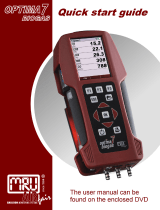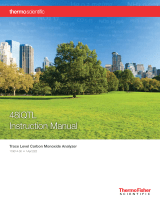
7
2. Press the OK button to begin an autozero countdown. Once the display shows AUTOZERO
COMPLETE, you are ready to use the instrument for your measurements. You can also initiate the
autozero the analyzer by first pressing the CALIB button. The cursor will rest on the first line of the
display, which states Zero All Sensors. Press OK. The display will automatically switch to the
MEASURE mode and the last line will execute a countdown. At the end of the countdown you are ready
to use the instrument.
3. If, at the end of the autozero countdown, the display shows an error message for a particular sensor, see
the troubleshooting table in section D of this chapter. The instrument will measure correctly all sensors
that do not show an error message.
4. With the analyzer in its case, connect the probe to the unit. One hose with the quick disconnect fitting
connects to the “Sample In” port, and the other hose connects to the “+” pressure port. The
thermocouple connector plugs into the “Stack” temperature connector. For the most accurate draft
measurements, another autozero calibration should be done (through the CALIBRATION button menu)
after the probe & hoses are fully connected to the analyzer but before the probe is inserted into the
stack.
5. The instrument can have up to six electrochemical gas sensors, one PID sensor, and three infrared (NDIR)
gas sensors. The Si-CA 8500 has three temperature sensors total.
6. All sensor readings are single range readings with ranges listed in Appendix A. The CO reading is an
exception. If the CO concentration exceeds the “Dilute CO” threshold that can be adjusted in the SETUP
menu, a CO dilution takes place automatically to increase the CO dilution measurement range to as high
as 20000 ppm. If the measured CO concentration exceeds the upper end of the set dilution range, then a
CO purge mode is initiated. If any of the ranges are exceeded for the other sensors the corresponding
parameter will read OVER on the display. In that case, it is strongly recommended to withdraw the probe
from the stack immediately and let the analyzer run with the pump on in a clean air environment to
prevent sensor saturation.
NOTE: For CO measurements greater than 20000 ppm, the optional CO NDIR sensor can
measure up to 15% CO.
7. Interior or exterior use. Protect the device from moisture and rain.
8. Only accessories which meet the manufacturer’s specifications shall be used.
9. The charger must be exclusively used for this Sauermann product. Using a different charger type may
damage the analyzer.
10. This device has been developed, produced and sold exclusively to trained and qualified experts in the
field of emissions monitoring. Appropriate training is necessary in order to guarantee a riskless use of this
instrument. Sauermann is not responsible for any possible accidents during its use.
11. The device must not be used in ATEX zones according to applicable standards.
12. Do not use the device next to explosive gases, vapors, or dust.
13. Do not block ventilation holes of the instrument.
14. Do not authorise pressures beyond the device limits. Please refer to the technical features described in
this user manual.
15. Be careful when removing gas sampling probe from the stack or pipe as it may be hot. A hot probe can
cause burns.
16. Allow the probe to cool down and the device to operate in clean air before storing the probe.
17. Clean the product with a dry and clean cloth after each use.
18. To avoid any risk due to voltage on the surface of the probe, it is important that the thermocouple is not
subjected to a voltage.
19. Any servicing must be carried out by a trained and qualified technician. The device power supply must be
turned off.





















